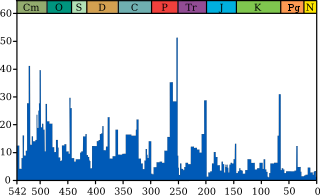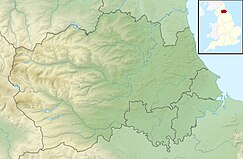멸종 사건 목록
List of extinction events
다음은 대멸종과 대멸종의 목록에는 대멸종과 [1]대멸종이 모두 포함되어 있습니다.
주요 멸종 사건(그림 참조)
| 주기 또는 초페론 | 멸종 | 날짜. | 생각할[2] 수 있는 원인 |
|---|---|---|---|
| 제4기 | 홀로세 대멸종 | c. BC 10,000 –계속 | 인간[3] |
| 제4기 멸종 사건 | 640,000, 74,000 및 13,000년 전 | 불명. 기후 변화, 대규모 화산 폭발 및 인간(대부분 인간의 과잉 [4][5][6]사냥에 의한)을 포함할 수 있습니다. | |
| 네오겐 | 플리오센플라이스토세 경계 소멸 | 2 Ma | 가능한 원인으로는 초신성이나[7][8] 엘타닌[9][10] 충격이 있다. |
| 중기의 마이오세 붕괴 | 14.5 Ma | 해양 순환 패턴의 변화에 따른 기후 변화.밀란코비치 사이클도[11] 영향을 미쳤을 수 있다. | |
| 고생대 | 에오세-올리고세 멸종 사건 | 33.9 Ma | 지구 냉각, 극지방 빙하, 해수면 하락, Popigai 임팩터[12] 등 다양한 원인 |
| 백악기 | 백악기-고생대멸종 사건 | 66 Ma | 칙술루브 임팩터; 데칸 트랩의 형성을 초래한 화산 활동이 기여했을 [13]수 있습니다. |
| 세노마니아-터키 경계 사건 | 94 Ma | 지구 온난화와 산성[14] 해양을 일으켰을 카리브해의 거대한 화성 지방과 관련된 수중 화산 활동일 가능성이 높다. | |
| 압티안 대멸종 | 117 Ma | 알려지지 않았지만, 라즈마할[15] 트랩의 화산 활동 때문일 수 있습니다. | |
| 쥐라기 | 쥐라기 말기(티토니아)의 멸종 | 145 Ma | 임팩터 및/또는 화산활동?[16] |
| 토아키아의 회전율 | 183 Ma | 카루페라르 이그네우스[17] 주 | |
| 트라이아스기 | 트라이아스기-쥬라기 멸종 사건 | 201 Ma | 가능한 원인으로는 점진적인 기후 변화, 중앙 대서양 마그마주[18] 화산 활동 또는 임팩터[19] 등이 있다. |
| 카르니안 충적 사건 | 230 Ma | Wrangellia 홍수 현무암,[20] 즉 Cimmerian orogeny의 융기 | |
| 페름기 | 페름기-트리아스기 멸종 사건 | 252 Ma | 알 수 없는.가능성에는 시베리아 트랩,[21] 충돌 이벤트(윌크스 랜드 크레이터),[22] 무산소 이벤트,[23] [24]빙하기 또는 기타 가능한 원인이 포함됩니다. |
| 카피타니아 말기 멸종 사건 | 260 Ma | 에미산 [25]트랩에 의한 화산활동으로 전지구 냉각 및 기타 영향 | |
| 올슨의 멸종 | 270 Ma | 알 수 없는.기후의 변화일 수도 있습니다. | |
| 석탄기 | 석탄 우림 붕괴 | 305 Ma | 기후의 급격한 변화나 스카게라크 중심 거대 이그네우스[26] 주의 화산 활동이 있을 가능성이 있다. |
| 데본기 | 데본기 후기 멸종 | 375~360 Ma | 빌루이 트랩,[27] 우들리 임팩터?[2] |
| 실루리아어 | 라우 이벤트 | 420 Ma | 해수면과 [28]화학의 변화? |
| 물데 이벤트 | 424 Ma | 해수면 [29]전지구적 하락? | |
| 이레비켄 사건 | 428 Ma | 심해저 산소 결핍증?[30] 밀란코비치 사이클?[31] | |
| 오르도비스기의 | 오르도비스기-실루리아 멸종 사건 | 450~440 Ma | 감마선 [32]폭발로 인한 지구 냉각 및 해수면 저하 또는 화산 활동 및 산소[33] 부족과 관련된 지구 온난화 |
| 캄브리아기 | 캄브리아-오르도비스기 멸종 사건 | 488 Ma | 칼카린지 대이그네우스 주?[34] |
| 드레스바흐 대멸종 사건 | 502 Ma | ||
| 보토미아 말기 멸종 사건 | 517 Ma | ||
| 선캄브리아어 | 에디아카라기 말기 멸종 | 542 Ma | 무산소 사건[35] |
| 대산소 이벤트 | 2400 Ma | 광합성의 발달과 눈덩이 지구 현상 가능성으로 인해 대기 중 산소 수치가 상승합니다.('휴론 빙하' 참조). |
타임라인
레퍼런스
- ^ 이미지의 일부 목록:멸종 강도png
- ^ a b Bond, David P. G.; Grasby, Stephen E. (2017-07-15). "On the causes of mass extinctions". Palaeogeography, Palaeoclimatology, Palaeoecology. Mass Extinction Causality: Records of Anoxia, Acidification, and Global Warming during Earth's Greatest Crises. 478: 3–29. Bibcode:2017PPP...478....3B. doi:10.1016/j.palaeo.2016.11.005. ISSN 0031-0182.
- ^ Ripple WJ, Wolf C, Newsome TM, Galetti M, Alamgir M, Crist E, Mahmoud MI, Laurance WF (13 November 2017). "World Scientists' Warning to Humanity: A Second Notice". BioScience. 67 (12): 1026–1028. doi:10.1093/biosci/bix125.
Moreover, we have unleashed a mass extinction event, the sixth in roughly 540 million years, wherein many current life forms could be annihilated or at least committed to extinction by the end of this century.
- ^ Sandom, Christopher; Faurby, Søren; Sandel, Brody; Svenning, Jens-Christian (4 June 2014). "Global late Quaternary megafauna extinctions linked to humans, not climate change". Proceedings of the Royal Society B. 281 (1787): 20133254. doi:10.1098/rspb.2013.3254. PMC 4071532. PMID 24898370.
- ^ Vignieri, S. (25 July 2014). "Vanishing fauna (Special issue)". Science. 345 (6195): 392–412. Bibcode:2014Sci...345..392V. doi:10.1126/science.345.6195.392. PMID 25061199.
Although some debate persists, most of the evidence suggests that humans were responsible for extinction of this Pleistocene fauna, and we continue to drive animal extinctions today through the destruction of wild lands, consumption of animals as a resource or a luxury, and persecution of species we see as threats or competitors.
- ^ Oppenheimer, Clive (2002-08-01). "Limited global change due to the largest known Quaternary eruption, Toba ≈74kyr BP?". Quaternary Science Reviews. 21 (14): 1593–1609. Bibcode:2002QSRv...21.1593O. doi:10.1016/S0277-3791(01)00154-8. ISSN 0277-3791.
- ^ Benitez, Narciso; et al. (2002). "Evidence for Nearby Supernova Explosions". Phys. Rev. Lett. 88 (8): 081101. arXiv:astro-ph/0201018. Bibcode:2002PhRvL..88h1101B. doi:10.1103/PhysRevLett.88.081101. PMID 11863949. S2CID 41229823.
- ^ Fimiani, L.; Cook, D.L.; Faestermann, T.; Gómez-Guzmán, J.M.; Hain, K.; Herzog, G.; Knie, K.; Korschinek, G.; Ludwig, P.; Park, J.; Reedy, R.C.; Rugel, G. (13 April 2016). "Interstellar 60Fe on the Surface of the Moon". Physical Review Letters. 116 (15): 151104. Bibcode:2016PhRvL.116o1104F. doi:10.1103/PhysRevLett.116.151104. PMID 27127953.
- ^ "Pliocene-Pleistocene boundary: did Eltanin asteroid kickstart the ice ages?". Archived from the original on 2017-10-03. Retrieved 2019-01-18.
- ^ "Did a Killer Asteroid Drive the Planet Into An Ice Age?". Universe Today. 20 September 2012.
- ^ Holbourn, Ann; Kuhnt, Wolfgang; Schulz, Michael; Erlenkeuser, Helmut (2005). "Impacts of orbital forcing and atmospheric carbon dioxide on Miocene ice-sheet expansion". Nature. 438 (7067): 483–87. Bibcode:2005Natur.438..483H. doi:10.1038/nature04123. PMID 16306989. S2CID 4406410.
- ^ "Russia's Popigai Meteor Crash Linked to Mass Extinction". Live Science. June 13, 2014.
- ^ Brusatte, Steve (2018). The Rise and Fall of the Dinosaurs. London: Picador. pp. 328–35. ISBN 978-1-5098-3009-1.
- ^ David Bond; Paul Wignall. "Large igneous provinces and mass extinctions: An update" (PDF). p. 17. Archived from the original (PDF) on 2016-01-24.
- ^ Singh, A. P.; Kumar, Niraj; Singh, Bijendra (2004). "Magmatic underplating beneath the Rajmahal Traps:Gravity signature and derived 3-D configuration.Proc". Indian Acad. Sci. (Earth Planet. Sci: 759–769. CiteSeerX 10.1.1.501.4945. doi:10.1007/BF02704035. S2CID 129952630.
- ^ Tennant, Jonathan P.; Mannion, Philip D.; Upchurch, Paul; Sutton, Mark D.; Price, Gregory D. (2017). "Biotic and environmental dynamics through the Late Jurassic–Early Cretaceous transition: evidence for protracted faunal and ecological turnover". Biological Reviews. 92 (2): 776–814. doi:10.1111/brv.12255. ISSN 1469-185X. PMC 6849608. PMID 26888552.
- ^ József Pálfy; Paul L. Smith (2000). "Synchrony between Early Jurassic extinction, oceanic anoxic event, and the Karoo-Ferrar flood basalt volcanism". Geology. 28 (8): 747–750. Bibcode:2000Geo....28..747P. doi:10.1130/0091-7613(2000)28<747:SBEJEO>2.0.CO;2.
- ^ Blackburn, Terrence J.; Olsen, Paul E.; Bowring, Samuel A.; McLean, Noah M.; Kent, Dennis V; Puffer, John; McHone, Greg; Rasbury, Troy; Et-Touhami7, Mohammed (2013). "Zircon U-Pb Geochronology Links the End-Triassic Extinction with the Central Atlantic Magmatic Province". Science. 340 (6135): 941–45. Bibcode:2013Sci...340..941B. CiteSeerX 10.1.1.1019.4042. doi:10.1126/science.1234204. PMID 23519213. S2CID 15895416.
- ^ Onoue, Tetsuji; Sato, Honami; Yamashita, Daisuke; Ikehara, Minoru; Yasukawa, Kazutaka; Fujinaga, Koichiro; Kato, Yasuhiro; Matsuoka, Atsushi (8 July 2016). "Bolide impact triggered the Late Triassic extinction event in equatorial Panthalassa". Scientific Reports. 6 (29609): 29609. Bibcode:2016NatSR...629609O. doi:10.1038/srep29609. PMC 4937377. PMID 27387863.
- ^ Dal Corso, J.; Mietto, P.; Newton, R.J.; Pancost, R.D.; Preto, N.; Roghi, G.; Wignall, P.B. (2012). "Discovery of a major negative δ13C spike in the Carnian (Late Triassic) linked to the eruption of Wrangellia flood basalts". Geology. 40 (1): 79–82. Bibcode:2012Geo....40...79D. doi:10.1130/g32473.1.
- ^ Campbell, I; Czamanske, G.; Fedorenko, V.; Hill, R.; Stepanov, V. (1992). "Synchronism of the Siberian Traps and the Permian-Triassic Boundary". Science. 258 (5089): 1760–63. Bibcode:1992Sci...258.1760C. doi:10.1126/science.258.5089.1760. PMID 17831657. S2CID 41194645.
- ^ von Frese, R; Potts, L.; Wells, S.; Leftwich, T.; Kim, H. (2009). "GRACE gravity evidence for an impact basin in Wilkes Land, Antarctica". Geochemistry, Geophysics, Geosystems. 10 (2): n/a. Bibcode:2009GGG....10.2014V. doi:10.1029/2008GC002149.
- ^ Wignall, P; Twitchett, R (2002). "Extent, duration, and nature of the Permian-Triassic superanoxic event". In Christian Koeberl; Kenneth G. MacLeod (eds.). Catastrophic events and mass extinctions: impacts and beyond. Geological Society of America. p. 396. doi:10.1130/0-8137-2356-6.395. ISBN 978-0813723563.
- ^ 온난화가 아니라 빙하기가 페름기-트라이아스기 멸종 사건을 설명한다 - UPI.com
- ^ Bond, David P.G.; Wignall, Paul B. (2014-09-01). Bond.pdf "Large igneous provinces and mass extinctions: An update" (PDF). Geological Society of America Special Papers. 505: 29–55. doi:10.1130/2014.2505(02). ISBN 9780813725055. ISSN 0072-1077.
{{cite journal}}:확인.url=값(도움말) - ^ Doblas, Miguel; R., OYARZUN; J., LOPEZ-RUIZ; J.M., CEBRIA; Youbi, Nasrrddine; V., MAHECHA; Lago San José, Marceliano; POCOVI; B., CABANIS (1998-12-01). "Permo-Carboniferous Volcanism in Europe and North Africa: a Superplume exhaust valve in The Center of Pangea". Journal of African Earth Sciences. 26: 89–99. doi:10.1016/S0899-5362(97)00138-3.
- ^ Ricci, J; et al. (2013). "New 40Ar/39Ar and K–Ar ages of the Viluy traps (Eastern Siberia): Further evidence for a relationship with the Frasnian–Famennian mass extinction". Palaeogeography, Palaeoclimatology, Palaeoecology. 386: 531–40. doi:10.1016/j.palaeo.2013.06.020.
- ^ Jeppsson, L. (1998). "Silurian oceanic events: summary of general characteristics". In Landing, E.; Johnson, M.E. (eds.). Silurian Cycles: Linkages of Dynamic Stratigraphy with Atmospheric, Oceanic and Tectonic Changes. James Hall Centennial Volume. New York State Museum Bulletin. Vol. 491. pp. 239–57.
- ^ Jeppsson, L.; Calner, M. (2007). "The Silurian Mulde Event and a scenario for secundo – secundo events". Earth and Environmental Science Transactions of the Royal Society of Edinburgh. 93 (2): 135–54. doi:10.1017/s0263593300000377. S2CID 129308139.
- ^ Munnecke, Axel; Samtleben, Christian; Bickert, Torsten (5 June 2003). "The Ireviken Event in the lower Silurian of Gotland, Sweden - relation to similar Palaeozoic and Proterozoic events". Palaeogeography, Palaeoclimatology, Palaeoecology. 195 (1–2): 119. Bibcode:2003PPP...195...99M. doi:10.1016/S0031-0182(03)00304-3.
- ^ Jeppsson, L (1997). "The anatomy of the Mid-Early Silurian Ireviken Event and a scenario for P-S events". In Brett, C.E.; Baird, G.C. (eds.). Paleontological Events: Stratigraphic, Ecological, and Evolutionary Implications. New York: Columbia University Press. pp. 451–92.
- ^ Melott, A.L.; et al. (2004). "Did a gamma-ray burst initiate the late Ordovician mass extinction?". International Journal of Astrobiology. 3 (1): 55–61. arXiv:astro-ph/0309415. Bibcode:2004IJAsB...3...55M. doi:10.1017/S1473550404001910. S2CID 13124815.
- ^ Bond, David P.G.; Grasby, Stephen E. (18 May 2020). "Late Ordovician mass extinction caused by volcanism, warming, and anoxia, not cooling and glaciation". Geology. 48 (8): 777–781. Bibcode:2020Geo....48..777B. doi:10.1130/G47377.1.
- ^ Ware, Bryant D.; Jourdan, Fred; Merle, Renaud; Chiaradia, Massimo; Hodges, Kyle (2018-04-01). "The Kalkarindji Large Igneous Province, Australia: Petrogenesis of the Oldest and Most Compositionally Homogenous Province of the Phanerozoic". Journal of Petrology. 59 (4): 635–665. Bibcode:2018JPet...59..635W. doi:10.1093/petrology/egy040. ISSN 0022-3530.
- ^ Zhang, Feifei; Xiao, Shuhai; Kendall, Brian; Romaniello, Stephen J.; Cui, Huan; Meyer, Mike; Gilleaudeau, Geoffrey J.; Kaufman, Alan J.; Anbar, Ariel D. (2018). "Extensive marine anoxia during the terminal Ediacaran Period". Science Advances. American Association for the Advancement of Science. 4 (6): eaan8983. Bibcode:2018SciA....4.8983Z. doi:10.1126/sciadv.aan8983. ISSN 2375-2548. PMC 6010336. PMID 29938217.




